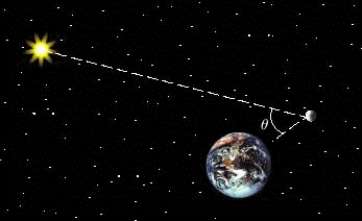Multiple Choice
The phases of the moon can be described using the phase angle  , determined by the sun, the moon, and the Earth, as shown in the figure. Because the moon orbits Earth,
, determined by the sun, the moon, and the Earth, as shown in the figure. Because the moon orbits Earth,  changes during the course of a month. The area of the region A of the moon, which appears illuminated to an observer on Earth, is given by
changes during the course of a month. The area of the region A of the moon, which appears illuminated to an observer on Earth, is given by  , where R = 1,080 mi is the radius of the moon. Approximate A for the following position of the moon:
, where R = 1,080 mi is the radius of the moon. Approximate A for the following position of the moon: 

A) A = 8,094,766 mi 2
B) A = 3,654,317 mi 2
C) A = 586,254 mi 2
D) A = 3,175,511 mi 2
E) A = 2,023,691 mi 2
Correct Answer:

Verified
Correct Answer:
Verified
Q2: The phases of the moon can be
Q3: Use the graph of a trigonometric function
Q4: Approximate, to the nearest 0.01 radian, all
Q5: Scientists sometimes use the formula <img src="https://d2lvgg3v3hfg70.cloudfront.net/TB8634/.jpg"
Q6: Approximate to four decimal places. <img src="https://d2lvgg3v3hfg70.cloudfront.net/TB8634/.jpg"
Q7: Verify the identity by transforming the left-hand
Q8: Find y by referring to the graph
Q9: Verify the identity by transforming the left-hand
Q10: Find the exact values of the six
Q11: Find the quadrant containing <img src="https://d2lvgg3v3hfg70.cloudfront.net/TB8634/.jpg" alt="Find